IMCO Oman: Integrity Management Project for ICT Integration
VerifiedAdded on 2023/06/13
|53
|14980
|163
Project
AI Summary
This integrity management project delves into the challenges faced by the International Maritime College (IMCO) in Oman regarding the integration of Information and Communication Technology (ICT) into its operations. The project identifies both internal and external factors contributing to these difficulties, such as stakeholder workload and resource constraints. It includes an organizational profile, structure, and strategy analysis, employing tools like McKinsey's 7S Framework and Fishbone diagrams to analyze the problem. The project provides functional and integrated analyses, highlighting the need for effective ICT integration to enhance profitability and market value. It also features a literature review of stakeholder approaches to similar issues, culminating in tailored recommendations for IMCO, emphasizing the importance of stakeholder investment in ICT integration and the potential for positive organizational change. The project concludes with reflections on the impact of the recommendations and their implications for the college's future.
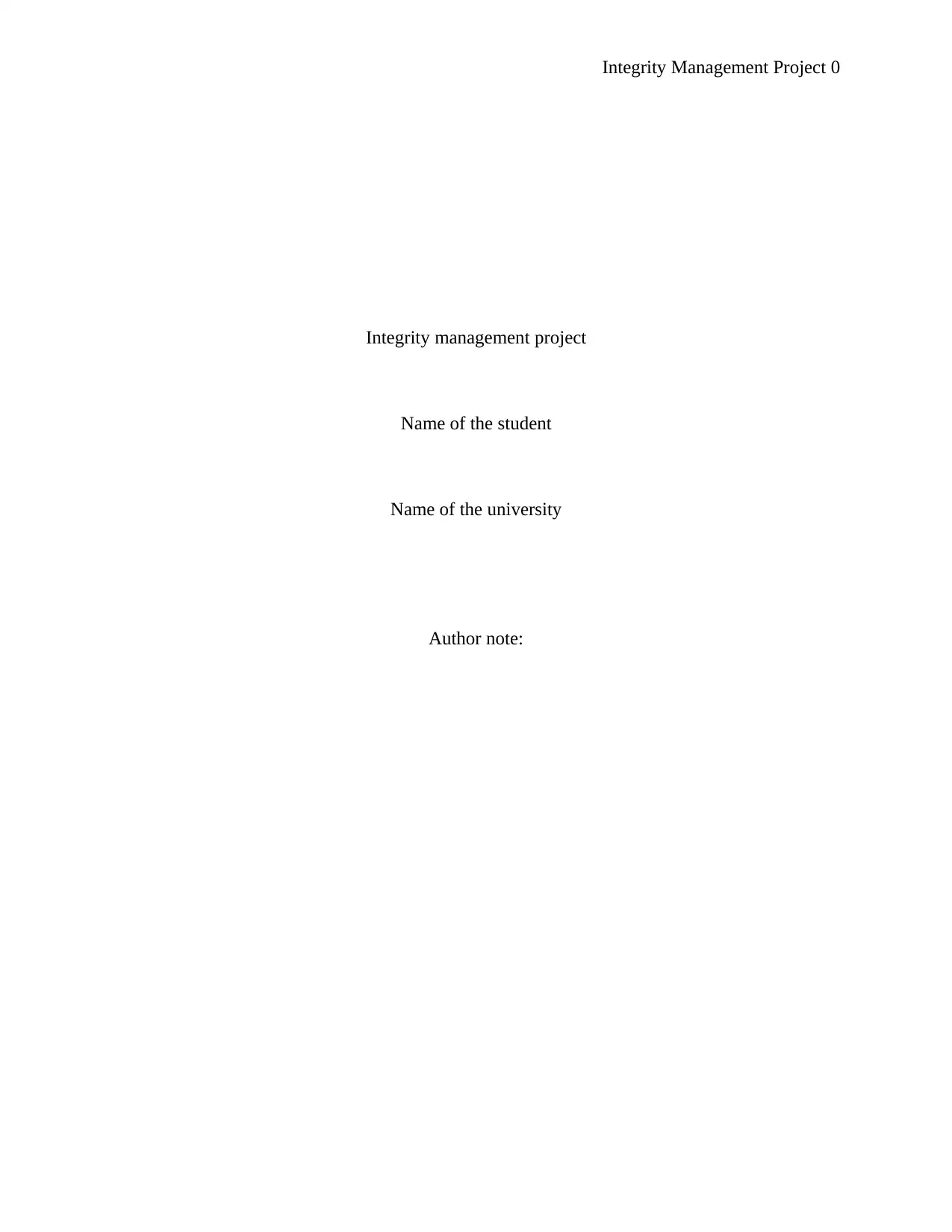
Integrity Management Project 0
Integrity management project
Name of the student
Name of the university
Author note:
Integrity management project
Name of the student
Name of the university
Author note:
Paraphrase This Document
Need a fresh take? Get an instant paraphrase of this document with our AI Paraphraser
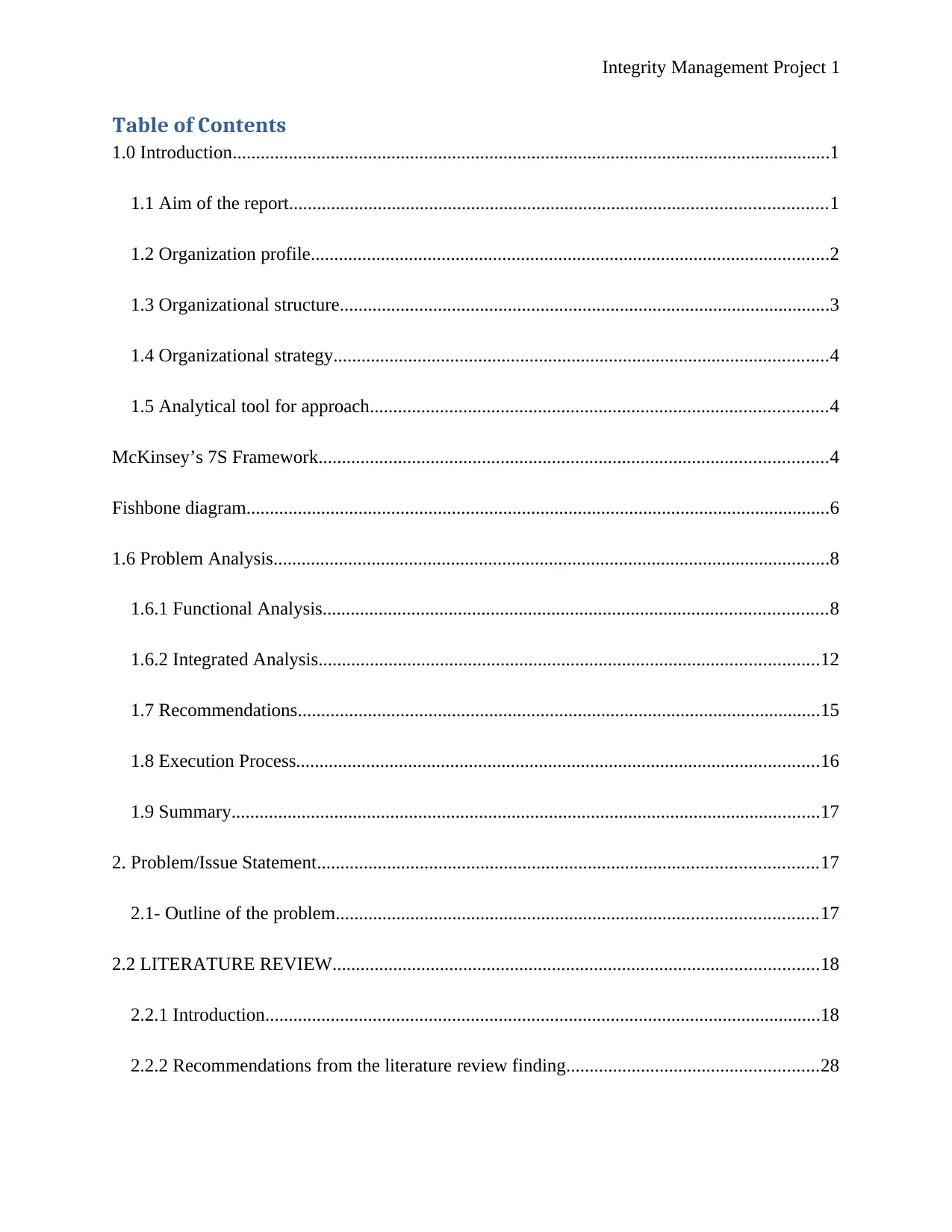
Integrity Management Project 1
Table of Contents
1.0 Introduction................................................................................................................................1
1.1 Aim of the report...................................................................................................................1
1.2 Organization profile...............................................................................................................2
1.3 Organizational structure.........................................................................................................3
1.4 Organizational strategy..........................................................................................................4
1.5 Analytical tool for approach..................................................................................................4
McKinsey’s 7S Framework.............................................................................................................4
Fishbone diagram.............................................................................................................................6
1.6 Problem Analysis.......................................................................................................................8
1.6.1 Functional Analysis............................................................................................................8
1.6.2 Integrated Analysis...........................................................................................................12
1.7 Recommendations................................................................................................................15
1.8 Execution Process................................................................................................................16
1.9 Summary..............................................................................................................................17
2. Problem/Issue Statement...........................................................................................................17
2.1- Outline of the problem.......................................................................................................17
2.2 LITERATURE REVIEW........................................................................................................18
2.2.1 Introduction.......................................................................................................................18
2.2.2 Recommendations from the literature review finding......................................................28
Table of Contents
1.0 Introduction................................................................................................................................1
1.1 Aim of the report...................................................................................................................1
1.2 Organization profile...............................................................................................................2
1.3 Organizational structure.........................................................................................................3
1.4 Organizational strategy..........................................................................................................4
1.5 Analytical tool for approach..................................................................................................4
McKinsey’s 7S Framework.............................................................................................................4
Fishbone diagram.............................................................................................................................6
1.6 Problem Analysis.......................................................................................................................8
1.6.1 Functional Analysis............................................................................................................8
1.6.2 Integrated Analysis...........................................................................................................12
1.7 Recommendations................................................................................................................15
1.8 Execution Process................................................................................................................16
1.9 Summary..............................................................................................................................17
2. Problem/Issue Statement...........................................................................................................17
2.1- Outline of the problem.......................................................................................................17
2.2 LITERATURE REVIEW........................................................................................................18
2.2.1 Introduction.......................................................................................................................18
2.2.2 Recommendations from the literature review finding......................................................28
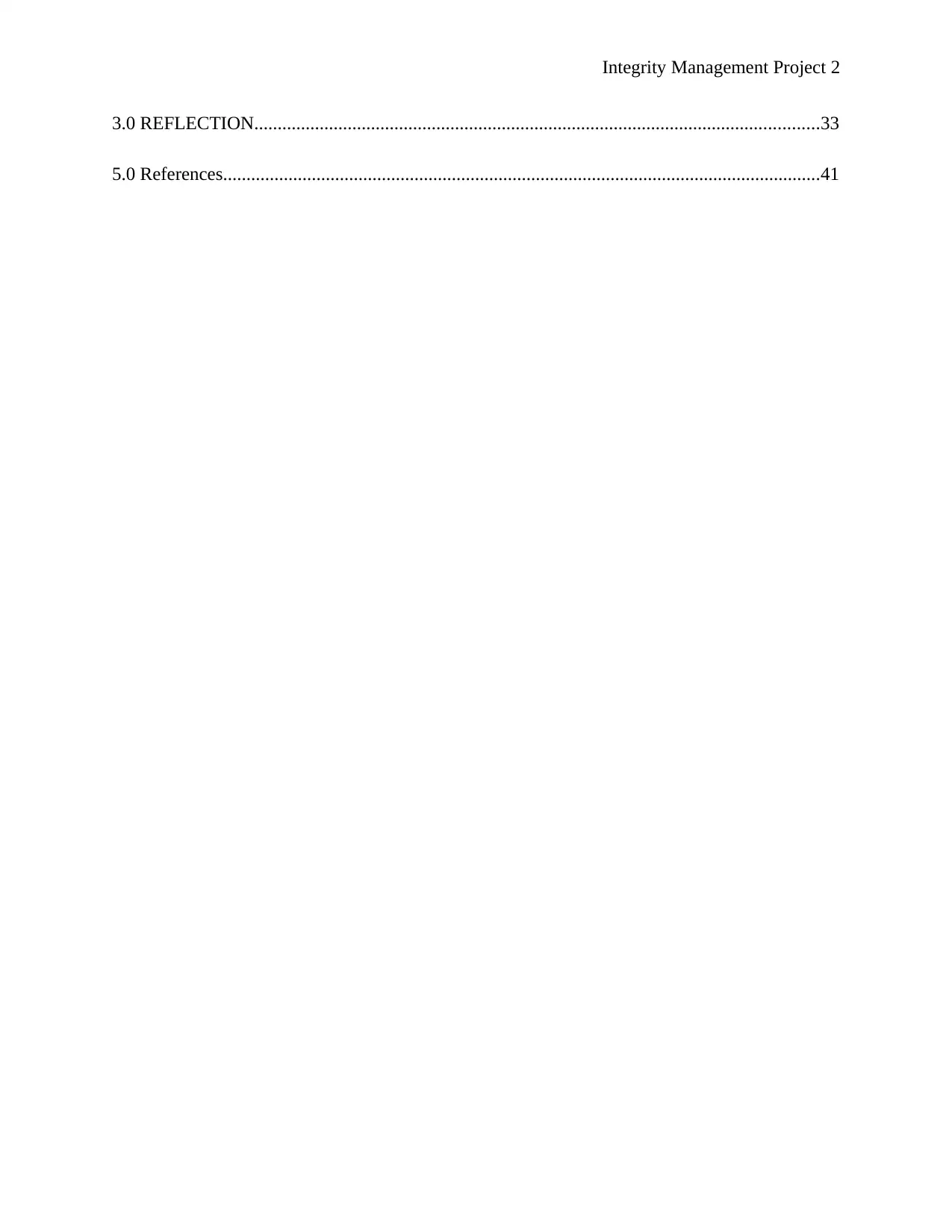
Integrity Management Project 2
3.0 REFLECTION.........................................................................................................................33
5.0 References................................................................................................................................41
3.0 REFLECTION.........................................................................................................................33
5.0 References................................................................................................................................41
⊘ This is a preview!⊘
Do you want full access?
Subscribe today to unlock all pages.

Trusted by 1+ million students worldwide
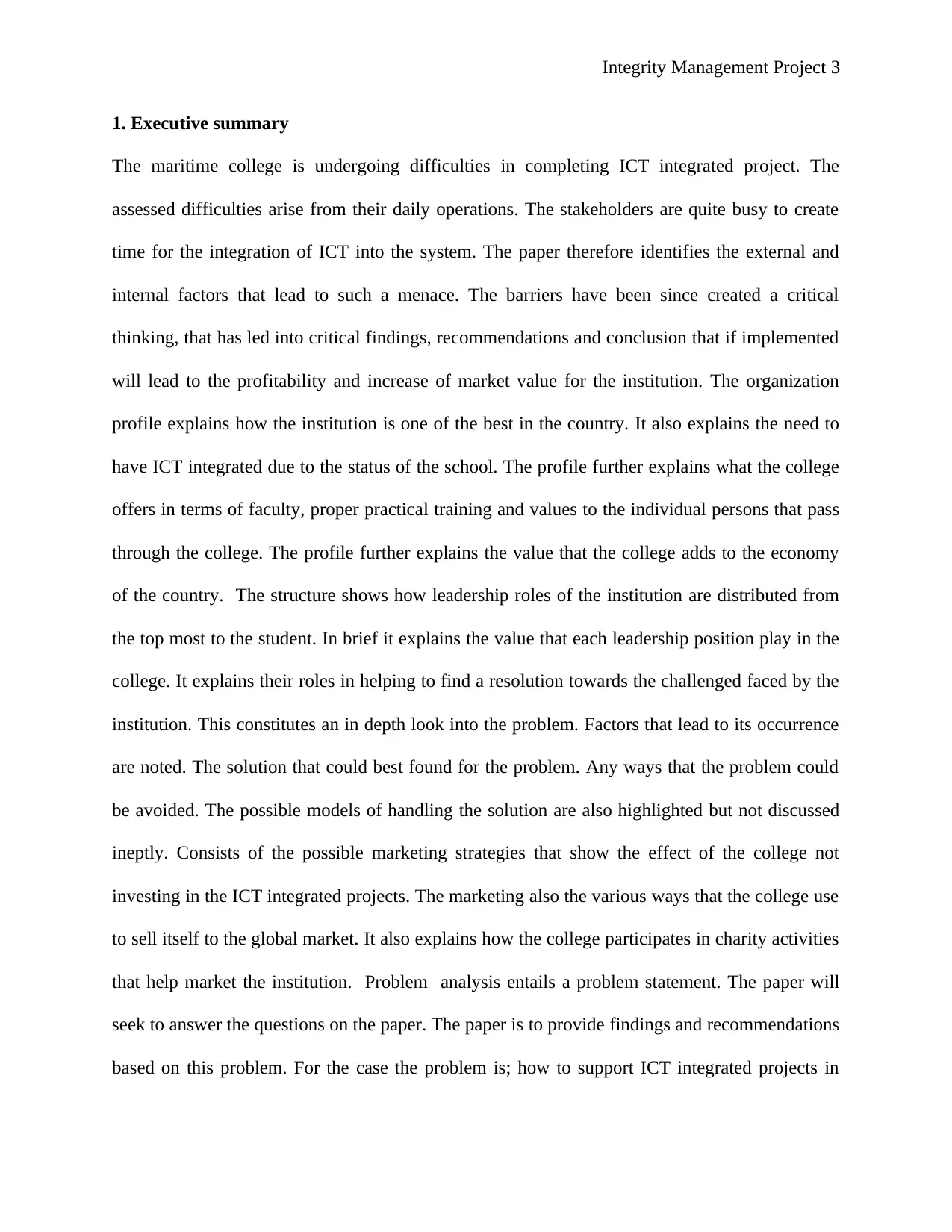
Integrity Management Project 3
1. Executive summary
The maritime college is undergoing difficulties in completing ICT integrated project. The
assessed difficulties arise from their daily operations. The stakeholders are quite busy to create
time for the integration of ICT into the system. The paper therefore identifies the external and
internal factors that lead to such a menace. The barriers have been since created a critical
thinking, that has led into critical findings, recommendations and conclusion that if implemented
will lead to the profitability and increase of market value for the institution. The organization
profile explains how the institution is one of the best in the country. It also explains the need to
have ICT integrated due to the status of the school. The profile further explains what the college
offers in terms of faculty, proper practical training and values to the individual persons that pass
through the college. The profile further explains the value that the college adds to the economy
of the country. The structure shows how leadership roles of the institution are distributed from
the top most to the student. In brief it explains the value that each leadership position play in the
college. It explains their roles in helping to find a resolution towards the challenged faced by the
institution. This constitutes an in depth look into the problem. Factors that lead to its occurrence
are noted. The solution that could best found for the problem. Any ways that the problem could
be avoided. The possible models of handling the solution are also highlighted but not discussed
ineptly. Consists of the possible marketing strategies that show the effect of the college not
investing in the ICT integrated projects. The marketing also the various ways that the college use
to sell itself to the global market. It also explains how the college participates in charity activities
that help market the institution. Problem analysis entails a problem statement. The paper will
seek to answer the questions on the paper. The paper is to provide findings and recommendations
based on this problem. For the case the problem is; how to support ICT integrated projects in
1. Executive summary
The maritime college is undergoing difficulties in completing ICT integrated project. The
assessed difficulties arise from their daily operations. The stakeholders are quite busy to create
time for the integration of ICT into the system. The paper therefore identifies the external and
internal factors that lead to such a menace. The barriers have been since created a critical
thinking, that has led into critical findings, recommendations and conclusion that if implemented
will lead to the profitability and increase of market value for the institution. The organization
profile explains how the institution is one of the best in the country. It also explains the need to
have ICT integrated due to the status of the school. The profile further explains what the college
offers in terms of faculty, proper practical training and values to the individual persons that pass
through the college. The profile further explains the value that the college adds to the economy
of the country. The structure shows how leadership roles of the institution are distributed from
the top most to the student. In brief it explains the value that each leadership position play in the
college. It explains their roles in helping to find a resolution towards the challenged faced by the
institution. This constitutes an in depth look into the problem. Factors that lead to its occurrence
are noted. The solution that could best found for the problem. Any ways that the problem could
be avoided. The possible models of handling the solution are also highlighted but not discussed
ineptly. Consists of the possible marketing strategies that show the effect of the college not
investing in the ICT integrated projects. The marketing also the various ways that the college use
to sell itself to the global market. It also explains how the college participates in charity activities
that help market the institution. Problem analysis entails a problem statement. The paper will
seek to answer the questions on the paper. The paper is to provide findings and recommendations
based on this problem. For the case the problem is; how to support ICT integrated projects in
Paraphrase This Document
Need a fresh take? Get an instant paraphrase of this document with our AI Paraphraser
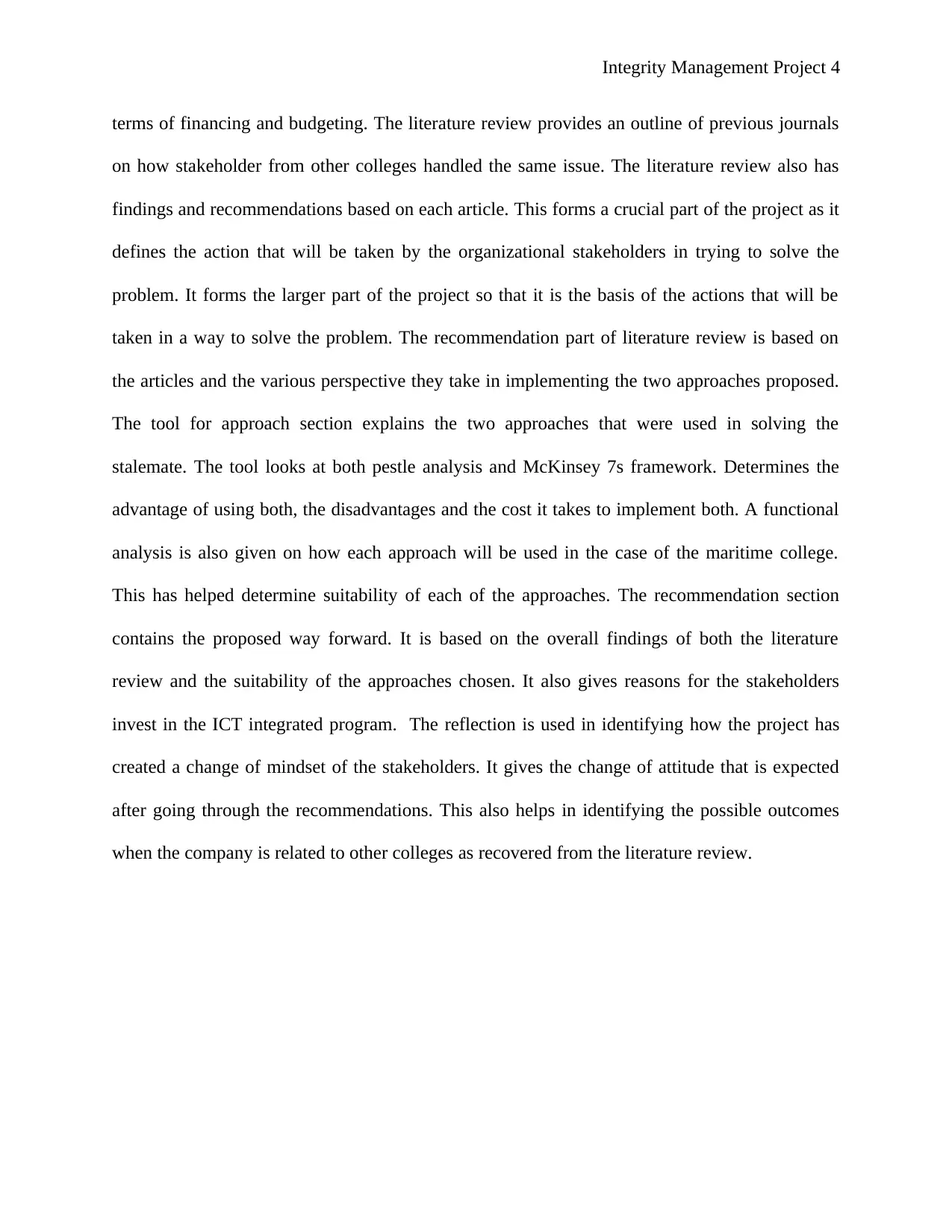
Integrity Management Project 4
terms of financing and budgeting. The literature review provides an outline of previous journals
on how stakeholder from other colleges handled the same issue. The literature review also has
findings and recommendations based on each article. This forms a crucial part of the project as it
defines the action that will be taken by the organizational stakeholders in trying to solve the
problem. It forms the larger part of the project so that it is the basis of the actions that will be
taken in a way to solve the problem. The recommendation part of literature review is based on
the articles and the various perspective they take in implementing the two approaches proposed.
The tool for approach section explains the two approaches that were used in solving the
stalemate. The tool looks at both pestle analysis and McKinsey 7s framework. Determines the
advantage of using both, the disadvantages and the cost it takes to implement both. A functional
analysis is also given on how each approach will be used in the case of the maritime college.
This has helped determine suitability of each of the approaches. The recommendation section
contains the proposed way forward. It is based on the overall findings of both the literature
review and the suitability of the approaches chosen. It also gives reasons for the stakeholders
invest in the ICT integrated program. The reflection is used in identifying how the project has
created a change of mindset of the stakeholders. It gives the change of attitude that is expected
after going through the recommendations. This also helps in identifying the possible outcomes
when the company is related to other colleges as recovered from the literature review.
terms of financing and budgeting. The literature review provides an outline of previous journals
on how stakeholder from other colleges handled the same issue. The literature review also has
findings and recommendations based on each article. This forms a crucial part of the project as it
defines the action that will be taken by the organizational stakeholders in trying to solve the
problem. It forms the larger part of the project so that it is the basis of the actions that will be
taken in a way to solve the problem. The recommendation part of literature review is based on
the articles and the various perspective they take in implementing the two approaches proposed.
The tool for approach section explains the two approaches that were used in solving the
stalemate. The tool looks at both pestle analysis and McKinsey 7s framework. Determines the
advantage of using both, the disadvantages and the cost it takes to implement both. A functional
analysis is also given on how each approach will be used in the case of the maritime college.
This has helped determine suitability of each of the approaches. The recommendation section
contains the proposed way forward. It is based on the overall findings of both the literature
review and the suitability of the approaches chosen. It also gives reasons for the stakeholders
invest in the ICT integrated program. The reflection is used in identifying how the project has
created a change of mindset of the stakeholders. It gives the change of attitude that is expected
after going through the recommendations. This also helps in identifying the possible outcomes
when the company is related to other colleges as recovered from the literature review.
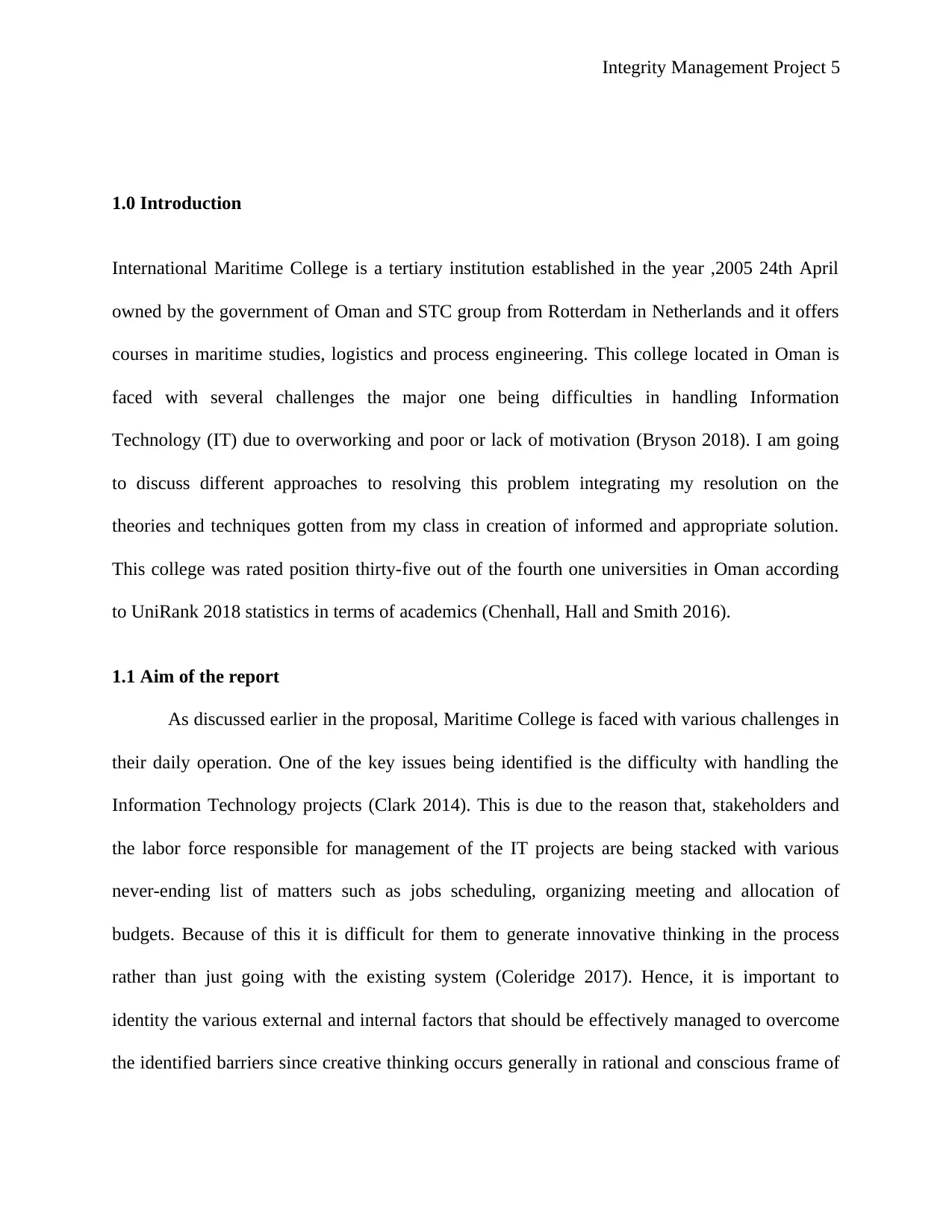
Integrity Management Project 5
1.0 Introduction
International Maritime College is a tertiary institution established in the year ,2005 24th April
owned by the government of Oman and STC group from Rotterdam in Netherlands and it offers
courses in maritime studies, logistics and process engineering. This college located in Oman is
faced with several challenges the major one being difficulties in handling Information
Technology (IT) due to overworking and poor or lack of motivation (Bryson 2018). I am going
to discuss different approaches to resolving this problem integrating my resolution on the
theories and techniques gotten from my class in creation of informed and appropriate solution.
This college was rated position thirty-five out of the fourth one universities in Oman according
to UniRank 2018 statistics in terms of academics (Chenhall, Hall and Smith 2016).
1.1 Aim of the report
As discussed earlier in the proposal, Maritime College is faced with various challenges in
their daily operation. One of the key issues being identified is the difficulty with handling the
Information Technology projects (Clark 2014). This is due to the reason that, stakeholders and
the labor force responsible for management of the IT projects are being stacked with various
never-ending list of matters such as jobs scheduling, organizing meeting and allocation of
budgets. Because of this it is difficult for them to generate innovative thinking in the process
rather than just going with the existing system (Coleridge 2017). Hence, it is important to
identity the various external and internal factors that should be effectively managed to overcome
the identified barriers since creative thinking occurs generally in rational and conscious frame of
1.0 Introduction
International Maritime College is a tertiary institution established in the year ,2005 24th April
owned by the government of Oman and STC group from Rotterdam in Netherlands and it offers
courses in maritime studies, logistics and process engineering. This college located in Oman is
faced with several challenges the major one being difficulties in handling Information
Technology (IT) due to overworking and poor or lack of motivation (Bryson 2018). I am going
to discuss different approaches to resolving this problem integrating my resolution on the
theories and techniques gotten from my class in creation of informed and appropriate solution.
This college was rated position thirty-five out of the fourth one universities in Oman according
to UniRank 2018 statistics in terms of academics (Chenhall, Hall and Smith 2016).
1.1 Aim of the report
As discussed earlier in the proposal, Maritime College is faced with various challenges in
their daily operation. One of the key issues being identified is the difficulty with handling the
Information Technology projects (Clark 2014). This is due to the reason that, stakeholders and
the labor force responsible for management of the IT projects are being stacked with various
never-ending list of matters such as jobs scheduling, organizing meeting and allocation of
budgets. Because of this it is difficult for them to generate innovative thinking in the process
rather than just going with the existing system (Coleridge 2017). Hence, it is important to
identity the various external and internal factors that should be effectively managed to overcome
the identified barriers since creative thinking occurs generally in rational and conscious frame of
⊘ This is a preview!⊘
Do you want full access?
Subscribe today to unlock all pages.

Trusted by 1+ million students worldwide
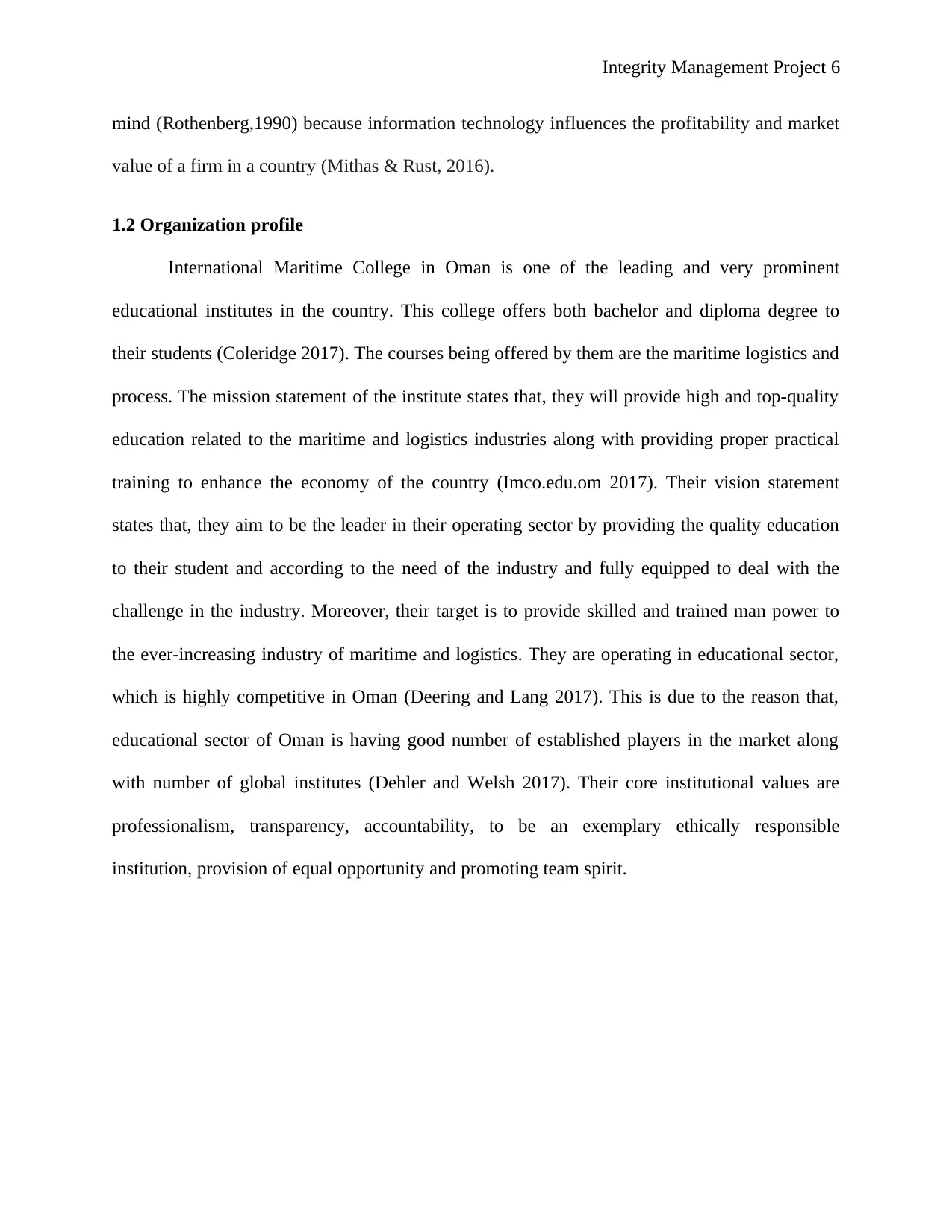
Integrity Management Project 6
mind (Rothenberg,1990) because information technology influences the profitability and market
value of a firm in a country (Mithas & Rust, 2016).
1.2 Organization profile
International Maritime College in Oman is one of the leading and very prominent
educational institutes in the country. This college offers both bachelor and diploma degree to
their students (Coleridge 2017). The courses being offered by them are the maritime logistics and
process. The mission statement of the institute states that, they will provide high and top-quality
education related to the maritime and logistics industries along with providing proper practical
training to enhance the economy of the country (Imco.edu.om 2017). Their vision statement
states that, they aim to be the leader in their operating sector by providing the quality education
to their student and according to the need of the industry and fully equipped to deal with the
challenge in the industry. Moreover, their target is to provide skilled and trained man power to
the ever-increasing industry of maritime and logistics. They are operating in educational sector,
which is highly competitive in Oman (Deering and Lang 2017). This is due to the reason that,
educational sector of Oman is having good number of established players in the market along
with number of global institutes (Dehler and Welsh 2017). Their core institutional values are
professionalism, transparency, accountability, to be an exemplary ethically responsible
institution, provision of equal opportunity and promoting team spirit.
mind (Rothenberg,1990) because information technology influences the profitability and market
value of a firm in a country (Mithas & Rust, 2016).
1.2 Organization profile
International Maritime College in Oman is one of the leading and very prominent
educational institutes in the country. This college offers both bachelor and diploma degree to
their students (Coleridge 2017). The courses being offered by them are the maritime logistics and
process. The mission statement of the institute states that, they will provide high and top-quality
education related to the maritime and logistics industries along with providing proper practical
training to enhance the economy of the country (Imco.edu.om 2017). Their vision statement
states that, they aim to be the leader in their operating sector by providing the quality education
to their student and according to the need of the industry and fully equipped to deal with the
challenge in the industry. Moreover, their target is to provide skilled and trained man power to
the ever-increasing industry of maritime and logistics. They are operating in educational sector,
which is highly competitive in Oman (Deering and Lang 2017). This is due to the reason that,
educational sector of Oman is having good number of established players in the market along
with number of global institutes (Dehler and Welsh 2017). Their core institutional values are
professionalism, transparency, accountability, to be an exemplary ethically responsible
institution, provision of equal opportunity and promoting team spirit.
Paraphrase This Document
Need a fresh take? Get an instant paraphrase of this document with our AI Paraphraser
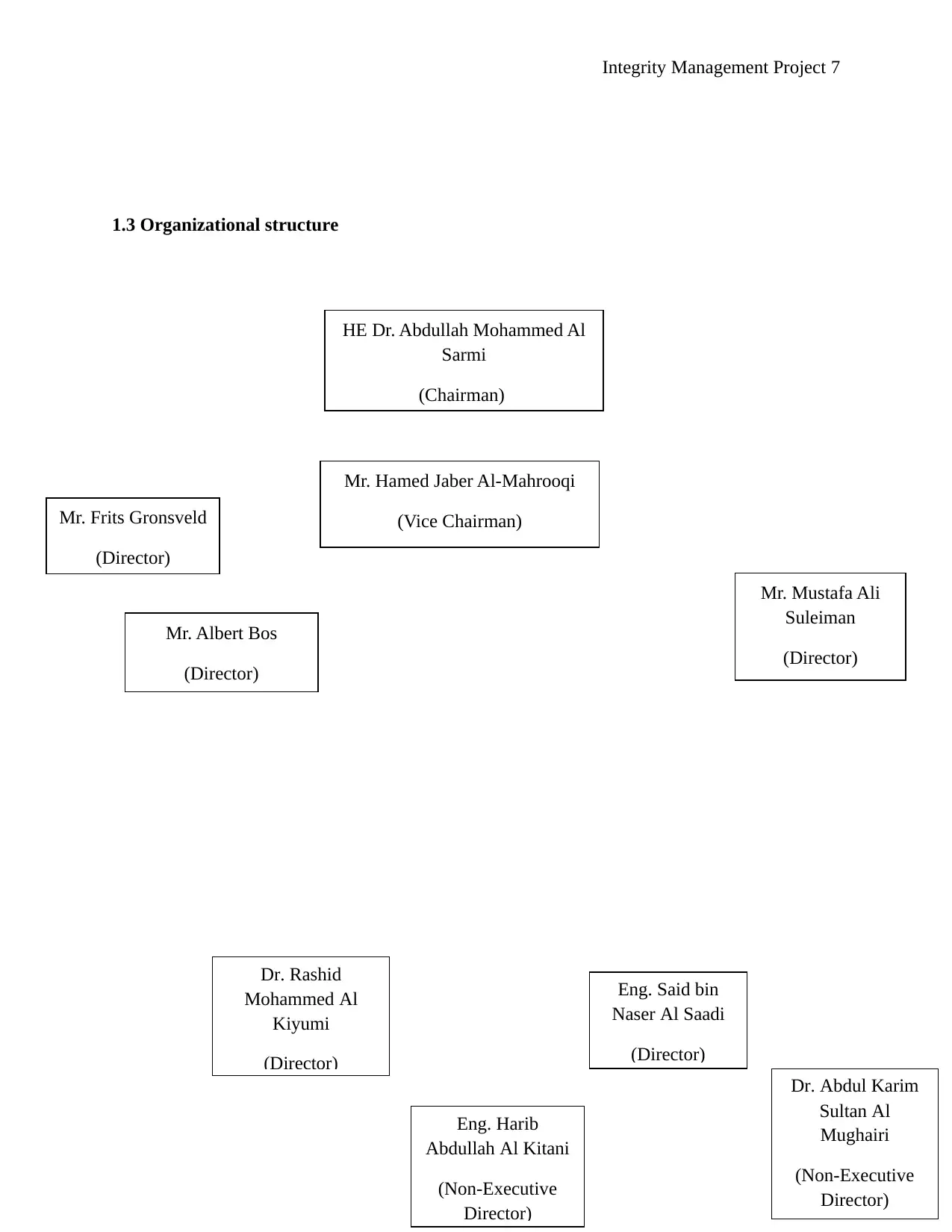
Integrity Management Project 7
1.3 Organizational structure
HE Dr. Abdullah Mohammed Al
Sarmi
(Chairman)
Mr. Hamed Jaber Al-Mahrooqi
(Vice Chairman)Mr. Frits Gronsveld
(Director)
Mr. Mustafa Ali
Suleiman
(Director)
Mr. Albert Bos
(Director)
Dr. Rashid
Mohammed Al
Kiyumi
(Director)
Eng. Said bin
Naser Al Saadi
(Director)
Eng. Harib
Abdullah Al Kitani
(Non-Executive
Director)
Dr. Abdul Karim
Sultan Al
Mughairi
(Non-Executive
Director)
1.3 Organizational structure
HE Dr. Abdullah Mohammed Al
Sarmi
(Chairman)
Mr. Hamed Jaber Al-Mahrooqi
(Vice Chairman)Mr. Frits Gronsveld
(Director)
Mr. Mustafa Ali
Suleiman
(Director)
Mr. Albert Bos
(Director)
Dr. Rashid
Mohammed Al
Kiyumi
(Director)
Eng. Said bin
Naser Al Saadi
(Director)
Eng. Harib
Abdullah Al Kitani
(Non-Executive
Director)
Dr. Abdul Karim
Sultan Al
Mughairi
(Non-Executive
Director)
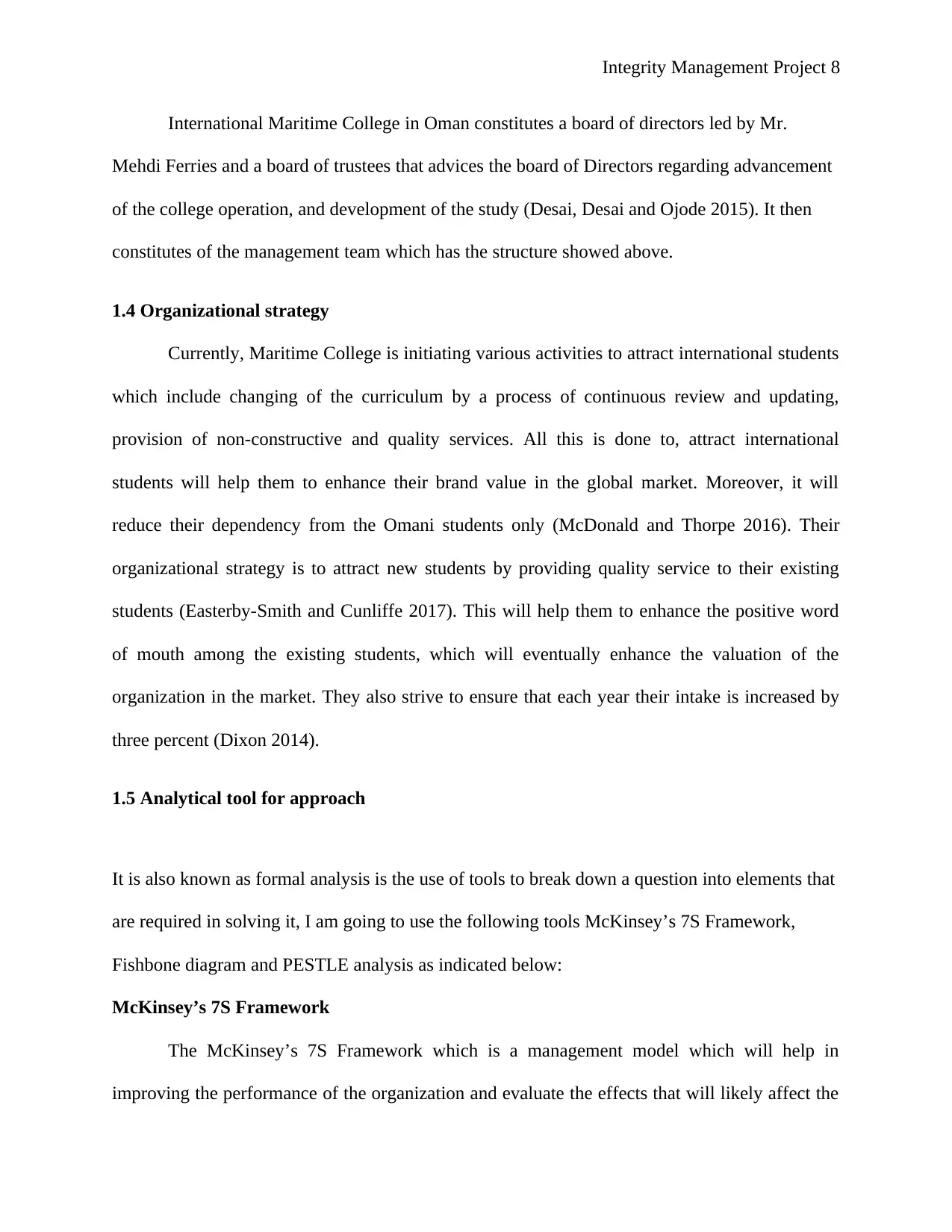
Integrity Management Project 8
International Maritime College in Oman constitutes a board of directors led by Mr.
Mehdi Ferries and a board of trustees that advices the board of Directors regarding advancement
of the college operation, and development of the study (Desai, Desai and Ojode 2015). It then
constitutes of the management team which has the structure showed above.
1.4 Organizational strategy
Currently, Maritime College is initiating various activities to attract international students
which include changing of the curriculum by a process of continuous review and updating,
provision of non-constructive and quality services. All this is done to, attract international
students will help them to enhance their brand value in the global market. Moreover, it will
reduce their dependency from the Omani students only (McDonald and Thorpe 2016). Their
organizational strategy is to attract new students by providing quality service to their existing
students (Easterby-Smith and Cunliffe 2017). This will help them to enhance the positive word
of mouth among the existing students, which will eventually enhance the valuation of the
organization in the market. They also strive to ensure that each year their intake is increased by
three percent (Dixon 2014).
1.5 Analytical tool for approach
It is also known as formal analysis is the use of tools to break down a question into elements that
are required in solving it, I am going to use the following tools McKinsey’s 7S Framework,
Fishbone diagram and PESTLE analysis as indicated below:
McKinsey’s 7S Framework
The McKinsey’s 7S Framework which is a management model which will help in
improving the performance of the organization and evaluate the effects that will likely affect the
International Maritime College in Oman constitutes a board of directors led by Mr.
Mehdi Ferries and a board of trustees that advices the board of Directors regarding advancement
of the college operation, and development of the study (Desai, Desai and Ojode 2015). It then
constitutes of the management team which has the structure showed above.
1.4 Organizational strategy
Currently, Maritime College is initiating various activities to attract international students
which include changing of the curriculum by a process of continuous review and updating,
provision of non-constructive and quality services. All this is done to, attract international
students will help them to enhance their brand value in the global market. Moreover, it will
reduce their dependency from the Omani students only (McDonald and Thorpe 2016). Their
organizational strategy is to attract new students by providing quality service to their existing
students (Easterby-Smith and Cunliffe 2017). This will help them to enhance the positive word
of mouth among the existing students, which will eventually enhance the valuation of the
organization in the market. They also strive to ensure that each year their intake is increased by
three percent (Dixon 2014).
1.5 Analytical tool for approach
It is also known as formal analysis is the use of tools to break down a question into elements that
are required in solving it, I am going to use the following tools McKinsey’s 7S Framework,
Fishbone diagram and PESTLE analysis as indicated below:
McKinsey’s 7S Framework
The McKinsey’s 7S Framework which is a management model which will help in
improving the performance of the organization and evaluate the effects that will likely affect the
⊘ This is a preview!⊘
Do you want full access?
Subscribe today to unlock all pages.

Trusted by 1+ million students worldwide
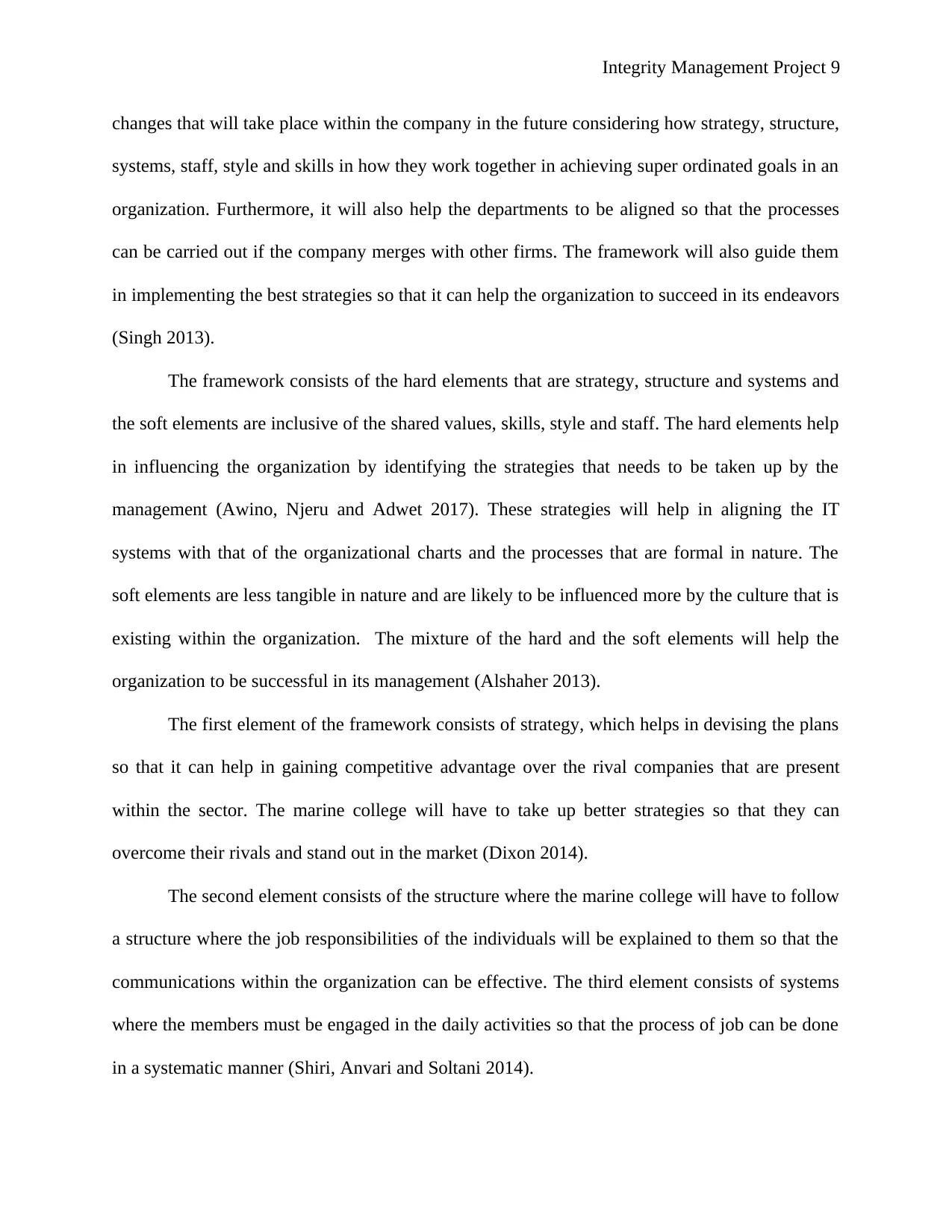
Integrity Management Project 9
changes that will take place within the company in the future considering how strategy, structure,
systems, staff, style and skills in how they work together in achieving super ordinated goals in an
organization. Furthermore, it will also help the departments to be aligned so that the processes
can be carried out if the company merges with other firms. The framework will also guide them
in implementing the best strategies so that it can help the organization to succeed in its endeavors
(Singh 2013).
The framework consists of the hard elements that are strategy, structure and systems and
the soft elements are inclusive of the shared values, skills, style and staff. The hard elements help
in influencing the organization by identifying the strategies that needs to be taken up by the
management (Awino, Njeru and Adwet 2017). These strategies will help in aligning the IT
systems with that of the organizational charts and the processes that are formal in nature. The
soft elements are less tangible in nature and are likely to be influenced more by the culture that is
existing within the organization. The mixture of the hard and the soft elements will help the
organization to be successful in its management (Alshaher 2013).
The first element of the framework consists of strategy, which helps in devising the plans
so that it can help in gaining competitive advantage over the rival companies that are present
within the sector. The marine college will have to take up better strategies so that they can
overcome their rivals and stand out in the market (Dixon 2014).
The second element consists of the structure where the marine college will have to follow
a structure where the job responsibilities of the individuals will be explained to them so that the
communications within the organization can be effective. The third element consists of systems
where the members must be engaged in the daily activities so that the process of job can be done
in a systematic manner (Shiri, Anvari and Soltani 2014).
changes that will take place within the company in the future considering how strategy, structure,
systems, staff, style and skills in how they work together in achieving super ordinated goals in an
organization. Furthermore, it will also help the departments to be aligned so that the processes
can be carried out if the company merges with other firms. The framework will also guide them
in implementing the best strategies so that it can help the organization to succeed in its endeavors
(Singh 2013).
The framework consists of the hard elements that are strategy, structure and systems and
the soft elements are inclusive of the shared values, skills, style and staff. The hard elements help
in influencing the organization by identifying the strategies that needs to be taken up by the
management (Awino, Njeru and Adwet 2017). These strategies will help in aligning the IT
systems with that of the organizational charts and the processes that are formal in nature. The
soft elements are less tangible in nature and are likely to be influenced more by the culture that is
existing within the organization. The mixture of the hard and the soft elements will help the
organization to be successful in its management (Alshaher 2013).
The first element of the framework consists of strategy, which helps in devising the plans
so that it can help in gaining competitive advantage over the rival companies that are present
within the sector. The marine college will have to take up better strategies so that they can
overcome their rivals and stand out in the market (Dixon 2014).
The second element consists of the structure where the marine college will have to follow
a structure where the job responsibilities of the individuals will be explained to them so that the
communications within the organization can be effective. The third element consists of systems
where the members must be engaged in the daily activities so that the process of job can be done
in a systematic manner (Shiri, Anvari and Soltani 2014).
Paraphrase This Document
Need a fresh take? Get an instant paraphrase of this document with our AI Paraphraser
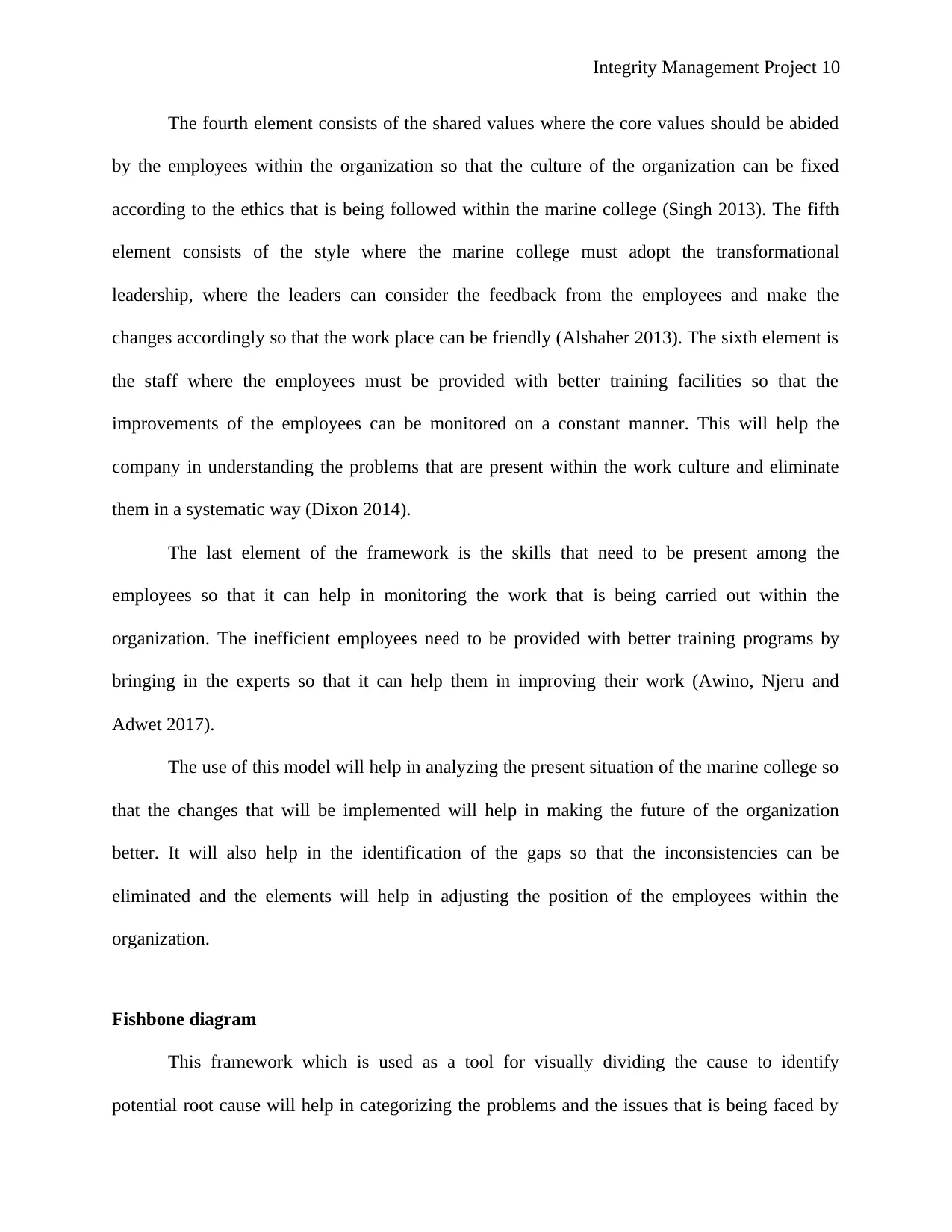
Integrity Management Project 10
The fourth element consists of the shared values where the core values should be abided
by the employees within the organization so that the culture of the organization can be fixed
according to the ethics that is being followed within the marine college (Singh 2013). The fifth
element consists of the style where the marine college must adopt the transformational
leadership, where the leaders can consider the feedback from the employees and make the
changes accordingly so that the work place can be friendly (Alshaher 2013). The sixth element is
the staff where the employees must be provided with better training facilities so that the
improvements of the employees can be monitored on a constant manner. This will help the
company in understanding the problems that are present within the work culture and eliminate
them in a systematic way (Dixon 2014).
The last element of the framework is the skills that need to be present among the
employees so that it can help in monitoring the work that is being carried out within the
organization. The inefficient employees need to be provided with better training programs by
bringing in the experts so that it can help them in improving their work (Awino, Njeru and
Adwet 2017).
The use of this model will help in analyzing the present situation of the marine college so
that the changes that will be implemented will help in making the future of the organization
better. It will also help in the identification of the gaps so that the inconsistencies can be
eliminated and the elements will help in adjusting the position of the employees within the
organization.
Fishbone diagram
This framework which is used as a tool for visually dividing the cause to identify
potential root cause will help in categorizing the problems and the issues that is being faced by
The fourth element consists of the shared values where the core values should be abided
by the employees within the organization so that the culture of the organization can be fixed
according to the ethics that is being followed within the marine college (Singh 2013). The fifth
element consists of the style where the marine college must adopt the transformational
leadership, where the leaders can consider the feedback from the employees and make the
changes accordingly so that the work place can be friendly (Alshaher 2013). The sixth element is
the staff where the employees must be provided with better training facilities so that the
improvements of the employees can be monitored on a constant manner. This will help the
company in understanding the problems that are present within the work culture and eliminate
them in a systematic way (Dixon 2014).
The last element of the framework is the skills that need to be present among the
employees so that it can help in monitoring the work that is being carried out within the
organization. The inefficient employees need to be provided with better training programs by
bringing in the experts so that it can help them in improving their work (Awino, Njeru and
Adwet 2017).
The use of this model will help in analyzing the present situation of the marine college so
that the changes that will be implemented will help in making the future of the organization
better. It will also help in the identification of the gaps so that the inconsistencies can be
eliminated and the elements will help in adjusting the position of the employees within the
organization.
Fishbone diagram
This framework which is used as a tool for visually dividing the cause to identify
potential root cause will help in categorizing the problems and the issues that is being faced by
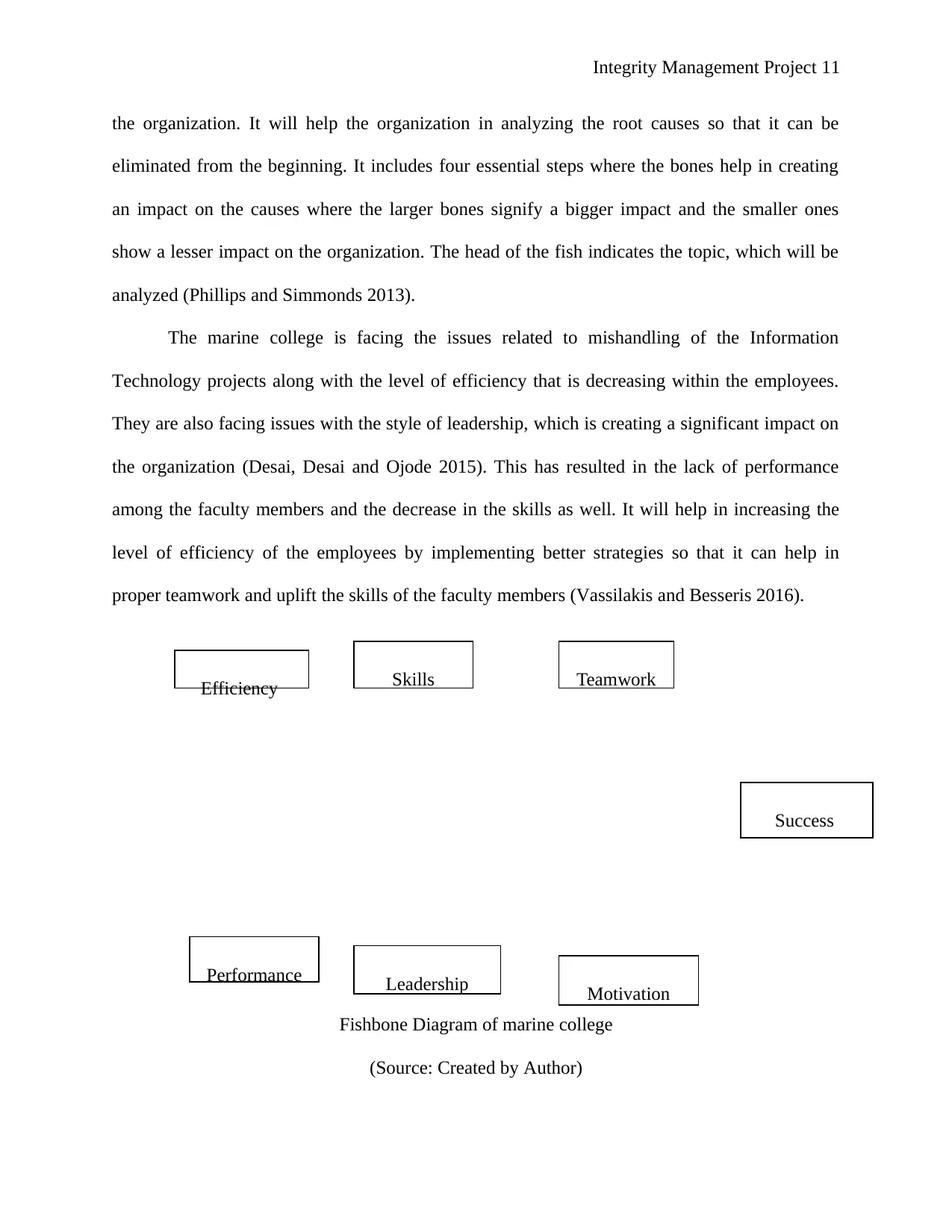
Integrity Management Project 11
the organization. It will help the organization in analyzing the root causes so that it can be
eliminated from the beginning. It includes four essential steps where the bones help in creating
an impact on the causes where the larger bones signify a bigger impact and the smaller ones
show a lesser impact on the organization. The head of the fish indicates the topic, which will be
analyzed (Phillips and Simmonds 2013).
The marine college is facing the issues related to mishandling of the Information
Technology projects along with the level of efficiency that is decreasing within the employees.
They are also facing issues with the style of leadership, which is creating a significant impact on
the organization (Desai, Desai and Ojode 2015). This has resulted in the lack of performance
among the faculty members and the decrease in the skills as well. It will help in increasing the
level of efficiency of the employees by implementing better strategies so that it can help in
proper teamwork and uplift the skills of the faculty members (Vassilakis and Besseris 2016).
Fishbone Diagram of marine college
(Source: Created by Author)
Efficiency
Performance
Skills
Leadership
Teamwork
Motivation
Success
the organization. It will help the organization in analyzing the root causes so that it can be
eliminated from the beginning. It includes four essential steps where the bones help in creating
an impact on the causes where the larger bones signify a bigger impact and the smaller ones
show a lesser impact on the organization. The head of the fish indicates the topic, which will be
analyzed (Phillips and Simmonds 2013).
The marine college is facing the issues related to mishandling of the Information
Technology projects along with the level of efficiency that is decreasing within the employees.
They are also facing issues with the style of leadership, which is creating a significant impact on
the organization (Desai, Desai and Ojode 2015). This has resulted in the lack of performance
among the faculty members and the decrease in the skills as well. It will help in increasing the
level of efficiency of the employees by implementing better strategies so that it can help in
proper teamwork and uplift the skills of the faculty members (Vassilakis and Besseris 2016).
Fishbone Diagram of marine college
(Source: Created by Author)
Efficiency
Performance
Skills
Leadership
Teamwork
Motivation
Success
⊘ This is a preview!⊘
Do you want full access?
Subscribe today to unlock all pages.

Trusted by 1+ million students worldwide
1 out of 53
Related Documents
Your All-in-One AI-Powered Toolkit for Academic Success.
+13062052269
info@desklib.com
Available 24*7 on WhatsApp / Email
![[object Object]](/_next/static/media/star-bottom.7253800d.svg)
Unlock your academic potential
Copyright © 2020–2025 A2Z Services. All Rights Reserved. Developed and managed by ZUCOL.




